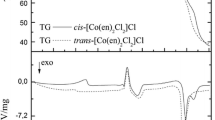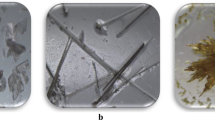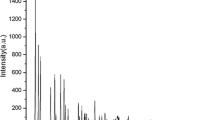Abstract
Thermal phase transitions of 1H,4H-piperazine-N,N′-diium diacetate were investigated by the differential scanning calorimetry (DSC) compared with piperazine and glacial acetic acid. The thermal stability of new sublimable molten salt was determined by thermogravimetric analysis (TGA), and the released gases after decomposition were identified by the thermogravimetric analysis–mass spectrometry (TG–MS). DSC profile of new sublimable organic molten salt was utterly different from those of its reactants, viz. piperazine and glacial acetic acid. Although the probability of reforming the acid and base remains negligible even at high temperatures (~ 300 °C) for some protic ionic liquids, the thermal behavior results exhibited that this molten salt could sublime at around 145 °C in the absence of high or ultrahigh vacuum. A new insight is described for sublimation and recondensation of the molten salt, including transforming the ionic salt in the solid phase into the molecular gas-phase cluster in the vapor phase, and reverse transformation during heating and cooling, respectively. The molten salt is nonhygroscopic contrary to piperazine and glacial acetic acid, which are highly hygroscopic. Furthermore, this work revealed for the first time that certain organic salts containing acceptor–donor hydrogen bonding moieties could be directly sublimed without liquefaction.
Graphical abstract










Similar content being viewed by others
References
Chen HY, Sachtler WMH. Promoted Fe/ZSM-5 catalysts prepared by sublimation: de-NOx activity and durability in H2O-rich streams. Catal Lett. 1998;50:125–30. https://doi.org/10.1023/A:1019079305250.
Kim MJ, Jung MJ, Kim YJ, Sung HK, Lee JY, Ham SJ, Park CP. Sublimable bis(β-iminoenolate)palladium(II) complexes and their application as catalysts in Suzuki-Miyaura reactions. Tetrahedron Lett. 2018;59:2989–93. https://doi.org/10.1016/j.tetlet.2018.06.051.
Usman W, Maqsood A. Catalyst free growth of single-crystalline bismuth nanorods by closed space sublimation technique. Mater Sci Poland. 2015;33:381–90. https://doi.org/10.1515/msp-2015-0061.
Zhang Y, Gao Y, Yao S, Li S, Asakura H, Teramura K, Wang HJ, Ma D. Sublimation-induced sulfur vacancies in MoS2 catalyst for one-pot synthesis of secondary amines. ACS Catal. 2019;9:7967–75. https://doi.org/10.1021/acscatal.9b01429.
Wu C, Luo Y, Zhao K, Yu X, Zhang X, Guo X. Recycling molybdenum from direct coal liquefaction residue: a new approach to enhance recycling efficiency. Catalysts. 2020;10:306. https://doi.org/10.3390/catal10030306.
Earle MJ, Esperanc JMSS, Gilea MA, Lopes JNC, Rebelo LPN, Magee JW, Seddon KR, Widegren JA. The distillation and volatility of ionic liquids. Nature. 2006;439:831–4. https://doi.org/10.1038/nature04451831.
Taylor AW, Lovelock KR, Deyko A, Licence P, Jones RG. High vacuum distillation of ionic liquids and separation of ionic liquid mixtures. Phys Chem Chem Phys. 2010;12:1772–83. https://doi.org/10.1039/B920931j.
Wasserscheid P. Chemistry: volatile times for ionic liquids. Nature. 2006;439:797. https://doi.org/10.1038/439797a.
Yoshizawa M, Xu W, Angell CA. Ionic liquids by proton transfer: Vapor pressure, conductivity, and the relevance of ∆pKa from aqueous solutions. J Am Chem Soc. 2003;125:15411–9. https://doi.org/10.1021/ja035783d.
Deyko A, Lovelock KRJ, Licence P, Jones RG. The vapour of imidazolium-based ionic liquids: a mass spectrometry study. Phys Chem Chem Phys. 2011;13:16841–50. https://doi.org/10.1039/C1CP21821B.
Sarma B, Chen J, Hsi HY, Myerson AS. Solid forms of pharmaceuticals: polymorphs, salts and cocrystals. Korean J Chem Eng. 2011;28:315–22. https://doi.org/10.1007/s11814-010-0520-0.
Aakeroy CB, Fasulo ME, Desper J. Cocrystal or salt: does it really matter? Mol Pharmaceutics. 2007;4:317–22. https://doi.org/10.1021/mp060126o.
Stahl PH, Wermuth CG, editors. Handbook of Pharmaceutical Salts: Properties. Zürich: Selection and Use; Verlag Helvetica Chimica Acta; 2002.
Wang X, Xu S, Jia L, Yang Y, Liu Y, Gong J, Wu S. Drug-drug salts of mefenamic acid\tolfenamic acid and piperazine to improve physicochemical properties for potential veterinary use. CrystEngComm. 2019;21:5284–91. https://doi.org/10.1039/C9CE00781D.
Zaharani L, Khaligh NG, Shahnavaz Z, Johan MR. The structure elucidation of new mono-core dicationic salt-containing chlorosulfonate counterion: Raman study of a pure sample of chlorosulfonate anion in the solid and liquid state. J Mol Struct. 2020;1216:128182. https://doi.org/10.1016/j.molstruc.2020.128182.
Khaligh NG, Mihankhah T, Johan MR. Synthesis of new low-viscous sulfonic acid-functionalized ionic liquid and its application as a Brönsted liquid acid catalyst for the one-pot mechanosynthesis of 4H-pyrans through the ball milling process. J Mol Liq. 2019;277:794–804. https://doi.org/10.1016/j.molliq.2019.01.024.
Shahnavaz Z, Khaligh NG, Zaharani L, Johan MR. The structure elucidation of new ionic liquid and its application for the synthesis of a series of novel triazolo[1,5-a]pyrimidine scaffolds. J Mol Struct. 2020;1219:128592. https://doi.org/10.1016/j.molstruc.2020.128592.
Zaharani L, Khaligh NG, Johan MR, Gorjian H. Synthesis and characterization of a new acid molten salt and the study of its thermal behaviour and catalytic activity in Fischer esterification. New J Chem. 2021;45:7081–8. https://doi.org/10.1039/D0NJ06273A.
Zaharani L, Khaligh NG, Johan MR. Synthesis, structure elucidation, vibrational and thermal behaviour study of new one-core dication molten-salt. J Mol Struct. 2021;1235:130134. https://doi.org/10.1016/j.molstruc.2021.130134.
Johari S, Zaharani L, Gorjian H, Johan MR, Khaligh NG. A novel sublimable organic salt: synthesis, characterization, thermal behavior, and catalytic activity for the synthesis of arylidene, heteroarylidene, and alkylidene malonates. Res Chem Intermed. 2022;48:361–77. https://doi.org/10.1007/s11164-021-04587-4.
An XW, Zhang ZL, Wang SN, Yan JQ, Hu RH. Investigation on bond energies: the heat of combustion of hippuric acid, piperazine and azacycloheptane. Acta Chim Sin. 1981;39:485–92.
Verevkin SP. Measurement and prediction of the monocarboxylic acids thermochemical properties. J Chem Eng Data. 2000;45:953–60. https://doi.org/10.1021/je990282m.
Dimian AC, Bildea CS, Kiss AA. Acetic Acid, In: Applications in Design and Simulation of Sustainable Chemical Processes, first edition, Elsevier, 2019. pp. 483–519. https://doi.org/10.1016/C2015-0-06856-3
Khalili F, Henni A, East ALL. pKa Values of some piperazines at (298, 303, 313, and 323) K. J Chem Eng Data. 2009;54:2914–7. https://doi.org/10.1021/je900005c.
Aakeröy CB, Desper J, Scott BMT. Balancing supramolecular reagents for reliable formation of co-crystals. Chem Comm. 2006;2006:1445–7. https://doi.org/10.1039/B517118K.
Acknowledgements
The authors used the International Collaboration Research Grants ST018-2022 and the University Malaysia Research Grant RU003-2021 to conduct this work. The authors are also grateful to all staff members in the Analytical and Testing Center of Nanotechnology & Catalysis Research Center for their partial support.
Author information
Authors and Affiliations
Contributions
Lia Zaharani was involved in the investigation, methodology, formal analysis, and data curation; Mohd Rafie Johan contributed to the funding acquisition and supervision; Nader Ghaffari Khaligh helped in the conceptualization, funding acquisition, formal analysis, project administration, supervision, validation, writing—original draft, and writing—review and editing.
Corresponding author
Ethics declarations
Conflict of interest
The authors declare that they have no known competing financial interests or personal relationships that could have appeared to influence the work reported in this paper.
Additional information
Publisher's Note
Springer Nature remains neutral with regard to jurisdictional claims in published maps and institutional affiliations.
Supplementary Information
Below is the link to the electronic supplementary material.
Rights and permissions
Springer Nature or its licensor (e.g. a society or other partner) holds exclusive rights to this article under a publishing agreement with the author(s) or other rightsholder(s); author self-archiving of the accepted manuscript version of this article is solely governed by the terms of such publishing agreement and applicable law.
About this article
Cite this article
Zaharani, L., Johan, M.R. & Khaligh, N.G. Study of thermal behavior of 1H,4H-piperazine-N,N′-diium diacetate and its sublimation mechanism: An nonhygroscopic piperazine salt with ionic or cocrystal structure?. J Therm Anal Calorim 147, 14183–14193 (2022). https://doi.org/10.1007/s10973-022-11717-6
Received:
Accepted:
Published:
Issue Date:
DOI: https://doi.org/10.1007/s10973-022-11717-6




